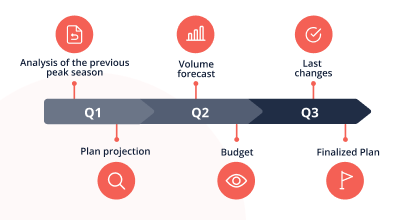2022 marked a record-breaking year in e-commerce revenue in Spain. According to the CNMV, during the fourth quarter of last year, online sales revenue increased by 16.2% year-on-year, reaching 19.65 billion euros, making it the quarter with the highest revenue in the historical series. The final quarter of the year is the one that sees the highest online sales, with milestones like Black Friday and the holiday season. This surge in commercial activity has a direct impact on logistics.
The peak season, or Peak Season, requires extensive planning and strategy that takes months of preparation. Getting the supply chain ready to handle the significant increase in Q4 activity poses a considerable logistical challenge. Here are some key factors to consider for success:
What will you find in this article?
1. The Best Teacher: Experience
The first step in planning for a Peak Season is to assess your previous peak season. This analysis helps identify areas for improvement and what has worked well. This gives you a good diagnosis of your supply chain’s performance and how it can be enhanced. Remember that analytical tools using data generated by your operations are an excellent option to gain a real understanding of your performance and pinpoint areas for improvement.
2. Time Is Your Best Ally
As mentioned earlier, proper planning should begin immediately after the previous Peak Season. Preparing for the most significant logistical event of the year takes time, and a well-structured quarterly plan might look like this:
Q1: Start outlining the next Peak Season project, using insights from the previous season and aligning your plan with your company’s objectives.
Q2: With the project in place, it’s time to plan the volume in terms of orders, packaging, labor, and costs. This allows you to create a budget and organize resources.
Q3: This is the time to fine-tune the project, identify any shortcomings, and rectify possible deviations. With the Peak Season approaching, it’s time to wrap everything up and be ready.

3. Embrace the Unpredictable
There are external factors that can disrupt your plans, and this is a reality that must be acknowledged. It’s challenging to predict, for example, fluctuations in fuel prices or the high level of inflation that occurred this year, which directly impacts operational costs. Therefore, it’s best to create a plan that can adapt to volatile environments. In this regard, flexibility is one of the most valuable qualities to aspire to.
4. Technology Does the Work for You
Talking about the benefits of technology in logistics might sound redundant, but, as expected, it also plays a crucial role in Peak Season planning. Modern logistics software not only provides valuable information for planning but also offers numerous features to make your logistics more flexible and solution-oriented, capable of tackling larger challenges.
Current logistics challenges require solutions that combine technology, automation, and innovation. At Deliverea, we develop tools that allow you to handle a higher volume of operations and grow your business. Count on our team for expert guidance.
If you liked this article, share it on your social media channels:



